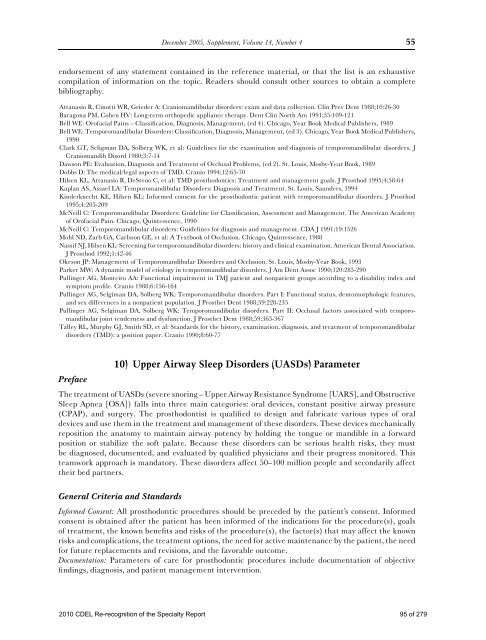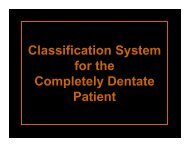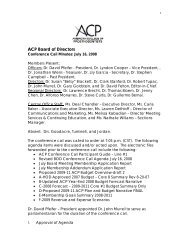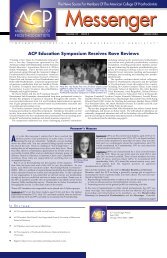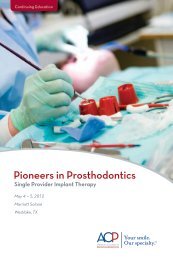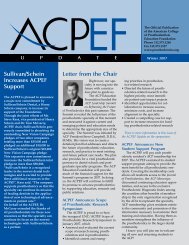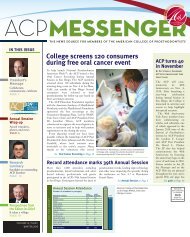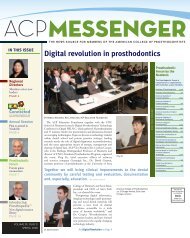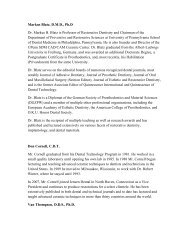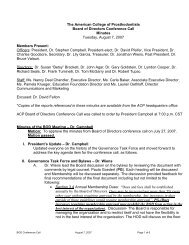54 Parameters <strong>of</strong> Care Tupac et al5. Preexisting systemic conditions6. Patient noncompliance with prescribed treatment7. Chronic pain behavior8. Psychosocial considerations9. Esthetic considerations10. Periodontal considerations11. Parafunctional habits12. Previous treatment13. Swallowing habits14. Tongue positionD. Standards <strong>of</strong> care1. Comprehensive clinical prosthodontic assessment [D0150, D0160, D0470, D0999 CDT-2005]2. Acute TMD Disorder [D0140, D7820, D7830, D7880, D7899, D7630, D9610 CDT 2005]3. Evaluation <strong>of</strong> previous treatment [D0170 CDT 2005]4. Appropriate diagnostic imaging [D0321, D0322, D0330, D0340, D0350 CDT 2005]5. Appropriate consultations/referrals6. Monitoring <strong>of</strong> adjunctive therapy [D0170 CDT 2005]7. Occlusal therapy, which may include: [(D2710-D2799, D7780, D8210, D8220, D9920, D9930,D9940, D9950-D9952, D9999 CDT 2005]a. Orthotic devicesb. Occlusal equilibrationc. Provisional restorationsd. Final restorations8. Maintenance [D0170 CDT 2005]9. Patient education10. Informed consent11. Pharmacological therapy [D9610, D9630 CDT 2005]12. Physical therapy [97014, 97032, 97001, 97002, 97110, 97014, 97504, 97010, 97039, 97112, 97520CPT 2005]13. Post-treatment follow-up careE. Specialty performance assessment criteria1. Favorable outcomes:a. Reduction/management <strong>of</strong> painb. Improved functionc. Improved intra-arch and interarch stability and supportd. Improved TM joint and or<strong>of</strong>acial muscle supporte. Acceptable patient compliance2. Known risks and complicationsa. Persistent or increased painb. Decreased stomatognathic functionc. Unanticipated motor or sensory nerve abnormalityd. Prolonged period <strong>of</strong> disabilitye. Psychological sequelaef. Recurrence <strong>of</strong> symptomsg. Postural limitationsh. Need for continued orthotic therapyi. Unfulfilled patient expectationsSelected References (Temporomandibular Disorders Parameter)This list <strong>of</strong> selected references is intended only to acknowledge some <strong>of</strong> the sources <strong>of</strong> information drawnupon in the preparation <strong>of</strong> this document. Citation <strong>of</strong> the reference material is not meant to imply2010 CDEL Re-recognition <strong>of</strong> the Specialty Report 94 <strong>of</strong> 279
December 2005, Supplement, Volume 14, Number 4 55endorsement <strong>of</strong> any statement contained in the reference material, or that the list is an exhaustivecompilation <strong>of</strong> information on the topic. Readers should consult other sources to obtain a completebibliography.Attanasio R, Cinotti WR, Grieder A: Craniomandibular disorders: exam and data collection. Clin Prev Dent 1988;10:26-30Baragona PM, Cohen HV: Long-term orthopedic appliance therapy. Dent Clin North Am 1991;35:109-121Bell WE: Or<strong>of</strong>acial Pains – Classification, Diagnosis, Management, (ed 4). Chicago, Year Book Medical Publishers, 1989Bell WE: Temporomandibular Disorders: Classification, Diagnosis, Management, (ed 3). Chicago, Year Book Medical Publishers,1990Clark GT, Seligman DA, Solberg WK, et al: Guidelines for the examination and diagnosis <strong>of</strong> temporomandibular disorders. JCraniomandib Disord 1980;3:7-14Dawson PE: Evaluation, Diagnosis and Treatment <strong>of</strong> Occlusal Problems, (ed 2). St. Louis, Mosby-Year Book, 1989Dobbs D: The medical/legal aspects <strong>of</strong> TMD. Cranio 1994;12:65-70Hilsen KL, Attanasio R, DeSteno C, et al: TMD prosthodontics: Treatment and management goals. J Prosthod 1995;4:58-64Kaplan AS, Assael LA: Temporomandibular Disorders: Diagnosis and Treatment. St. Louis, Saunders, 1994Kinderknecht KE, Hilsen KL: Informed consent for the prosthodontic patient with temporomandibular disorders. J Prosthod1995;4:205-209McNeill C: Temporomandibular Disorders: Guideline for Classification, Assessment and Management. The <strong>American</strong> Academy<strong>of</strong> Or<strong>of</strong>acial Pain. Chicago, Quintessence, 1990McNeill C: Temporomandibular disorders: Guidelines for diagnosis and management. CDA J 1991;19:1526Mohl ND, Zarb GA, Carlsson GE, et al: A Textbook <strong>of</strong> Occlusion. Chicago, Quintessence, 1988Nassif NJ, Hilsen KL: Screening for temporomandibular disorders: history and clinical examination. <strong>American</strong> Dental Association.J Prosthod 1992;1:42-46Okeson JP: Management <strong>of</strong> Temporomandibular Disorders and Occlusion. St. Louis, Mosby-Year Book, 1993Parker MW: A dynamic model <strong>of</strong> etiology in temporomandibular disorders. J Am Dent Assoc 1990;120:283-290Pullinger AG, Monteiro AA: Functional impairment in TMJ patient and nonpatient groups according to a disability index andsymptom pr<strong>of</strong>ile. Cranio 1988;6:156-164Pullinger AG, Selgiman DA, Solberg WK: Temporomandibular disorders. Part I: Functional status, dentomorphologic features,and sex differences in a nonpatient population. J Prosthet Dent 1988;59:228-235Pullinger AG, Selgiman DA, Solberg WK: Temporomandibular disorders. Part II: Occlusal factors associated with temporomandibularjoint tenderness and dysfunction. J Prosthet Dent 1988;59:363-367Talley RL, Murphy GJ, Smith SD, et al: Standards for the history, examination, diagnosis, and treatment <strong>of</strong> temporomandibulardisorders (TMD): a position paper. Cranio 1990;8:60-77Preface10) Upper Airway Sleep Disorders (UASDs) ParameterThe treatment <strong>of</strong> UASDs (severe snoring – Upper Airway Resistance Syndrome [UARS], and ObstructiveSleep Apnea [OSA]) falls into three main categories: oral devices, constant positive airway pressure(CPAP), and surgery. The prosthodontist is qualified to design and fabricate various types <strong>of</strong> oraldevices and use them in the treatment and management <strong>of</strong> these disorders. These devices mechanicallyreposition the anatomy to maintain airway potency by holding the tongue or mandible in a forwardposition or stabilize the s<strong>of</strong>t palate. Because these disorders can be serious health risks, they mustbe diagnosed, documented, and evaluated by qualified physicians and their progress monitored. Thisteamwork approach is mandatory. These disorders affect 50–100 million people and secondarily affecttheir bed partners.General Criteria and StandardsInformed Consent: All prosthodontic procedures should be preceded by the patient’s consent. Informedconsent is obtained after the patient has been informed <strong>of</strong> the indications for the procedure(s), goals<strong>of</strong> treatment, the known benefits and risks <strong>of</strong> the procedure(s), the factor(s) that may affect the knownrisks and complications, the treatment options, the need for active maintenance by the patient, the needfor future replacements and revisions, and the favorable outcome.Documentation: Parameters <strong>of</strong> care for prosthodontic procedures include documentation <strong>of</strong> objectivefindings, diagnosis, and patient management intervention.2010 CDEL Re-recognition <strong>of</strong> the Specialty Report 95 <strong>of</strong> 279
- Page 1:
COUNCIL ON DENTAL EDUCATION AND LIC
- Page 4 and 5:
A. General InformationThe American
- Page 7 and 8:
The American College of Prosthodont
- Page 9 and 10:
The American College of Prosthodont
- Page 11 and 12:
The American College of Prosthodont
- Page 13 and 14:
The American College of Prosthodont
- Page 15 and 16:
The American College of Prosthodont
- Page 17 and 18:
Changes in Scope of PracticeThe Ame
- Page 19 and 20:
The American College of Prosthodont
- Page 22 and 23:
The American College of Prosthodont
- Page 24 and 25:
The American College of Prosthodont
- Page 26 and 27:
ReferencesThe American College of P
- Page 28 and 29:
The American College of Prosthodont
- Page 30 and 31:
COUNCIL ON DENTAL EDUCATION AND LIC
- Page 33 and 34:
ENVISIONED FUTURE~ 10-30 YEAR HORIZ
- Page 35 and 36:
Prosthodontists will provide prosth
- Page 37 and 38:
GOALS AND OBJECTIVES~ 3-5 YEAR PLAN
- Page 39 and 40:
E4. Create effective linkages to fu
- Page 41 and 42:
Journal of ProsthodonticsImplant, E
- Page 43 and 44: December 2005, Supplement, Volume 1
- Page 45 and 46: December 2005, Supplement, Volume 1
- Page 47 and 48: December 2005, Supplement, Volume 1
- Page 49 and 50: December 2005, Supplement, Volume 1
- Page 51 and 52: December 2005, Supplement, Volume 1
- Page 53 and 54: December 2005, Supplement, Volume 1
- Page 55 and 56: December 2005, Supplement, Volume 1
- Page 57 and 58: December 2005, Supplement, Volume 1
- Page 59 and 60: December 2005, Supplement, Volume 1
- Page 61 and 62: December 2005, Supplement, Volume 1
- Page 63 and 64: December 2005, Supplement, Volume 1
- Page 65 and 66: December 2005, Supplement, Volume 1
- Page 67 and 68: December 2005, Supplement, Volume 1
- Page 69 and 70: December 2005, Supplement, Volume 1
- Page 71 and 72: December 2005, Supplement, Volume 1
- Page 73 and 74: December 2005, Supplement, Volume 1
- Page 75 and 76: December 2005, Supplement, Volume 1
- Page 77 and 78: December 2005, Supplement, Volume 1
- Page 79 and 80: December 2005, Supplement, Volume 1
- Page 81 and 82: December 2005, Supplement, Volume 1
- Page 83 and 84: December 2005, Supplement, Volume 1
- Page 85 and 86: December 2005, Supplement, Volume 1
- Page 87 and 88: December 2005, Supplement, Volume 1
- Page 89 and 90: December 2005, Supplement, Volume 1
- Page 91 and 92: December 2005, Supplement, Volume 1
- Page 93: December 2005, Supplement, Volume 1
- Page 97 and 98: December 2005, Supplement, Volume 1
- Page 99 and 100: December 2005, Supplement, Volume 1
- Page 101 and 102: December 2005, Supplement, Volume 1
- Page 103 and 104: December 2005, Supplement, Volume 1
- Page 105 and 106: December 2005, Supplement, Volume 1
- Page 107 and 108: December 2005, Supplement, Volume 1
- Page 109 and 110: December 2005, Supplement, Volume 1
- Page 111 and 112: December 2005, Supplement, Volume 1
- Page 113 and 114: December 2005, Supplement, Volume 1
- Page 115 and 116: December 2005, Supplement, Volume 1
- Page 117 and 118: December 2005, Supplement, Volume 1
- Page 119 and 120: December 2005, Supplement, Volume 1
- Page 121 and 122: December 2005, Supplement, Volume 1
- Page 123 and 124: December 2005, Supplement, Volume 1
- Page 125 and 126: December 2005, Supplement, Volume 1
- Page 127 and 128: December 2005, Supplement, Volume 1
- Page 129 and 130: December 2005, Supplement, Volume 1
- Page 131 and 132: December 2005, Supplement, Volume 1
- Page 133 and 134: December 2005, Supplement, Volume 1
- Page 135 and 136: December 2005, Supplement, Volume 1
- Page 137 and 138: December 2005, Supplement, Volume 1
- Page 139 and 140: December 2005, Supplement, Volume 1
- Page 141 and 142: December 2005, Supplement, Volume 1
- Page 143 and 144: December 2005, Supplement, Volume 1
- Page 145 and 146:
COUNCIL ON DENTAL EDUCATION AND LIC
- Page 147 and 148:
28 Cllas$caizon of Complete Edentul
- Page 149 and 150:
30 Clmsjfication ofCom&e Edentulirm
- Page 151 and 152:
32 Clarszjicatwn ofcomplete Edeiitu
- Page 153 and 154:
Figure 14. Class Ipatient. (A) Pano
- Page 155 and 156:
Figure 16. Class KU patient. (A) Pa
- Page 157 and 158:
38 Clm$cation of Cumllete EdClass 1
- Page 159 and 160:
COUNCIL ON DENTAL EDUCATION AND LIC
- Page 161 and 162:
182 Classification System for Parti
- Page 163 and 164:
184 Classification System Jor Parti
- Page 165 and 166:
186 Classification Systemfor Partia
- Page 167 and 168:
188 Classification System jor Parti
- Page 169 and 170:
Figure 4. Class IV palienl. Edenlul
- Page 171 and 172:
I192 Classification Sy stemfor Part
- Page 173 and 174:
COUNCIL ON DENTAL EDUCATION AND LIC
- Page 175 and 176:
74 Classification System for the Co
- Page 177 and 178:
76 Classification System for the Co
- Page 179 and 180:
78 Classification System for the Co
- Page 181 and 182:
80 Classification System for the Co
- Page 183 and 184:
82 Classification System for the Co
- Page 185 and 186:
ORALCANCERSCREENING,EXAMINATIONANDB
- Page 187 and 188:
ChrisBornITProjectManagerLomaLindaU
- Page 189 and 190:
THOSEATRISKFORORALCANCERWhoisatrisk
- Page 191 and 192:
Inaprospectivestudy(NIH‐AARPDieta
- Page 193 and 194:
AgedataWhenexaminingdatafrom19agegr
- Page 195 and 196:
Whatisthestatusofcommunityscreening
- Page 197 and 198:
ReferencesArbesSJ,OlshanAF.CaplanDJ
- Page 199 and 200:
THEPROCESSOFONCOGENESISIntroduction
- Page 201 and 202:
tightregulationoftranscriptionaleve
- Page 203 and 204:
withalloftheotherhallmarksinplace,a
- Page 205 and 206:
THERADIOGRAPHICEXAMINATIONCanradiog
- Page 207 and 208:
thinningorperforationofthecortices,
- Page 209 and 210:
lymphoma)andprimarycarcinomas,areen
- Page 211 and 212:
Figure4EffectsonadjacentstructuresW
- Page 213 and 214:
fromaprimarylesioninboneorthesoftti
- Page 215 and 216:
THEORALCANCERSCREENINGEXAMINATIONTh
- Page 217 and 218:
Society’sABCDERule:lookforAsymmet
- Page 219 and 220:
Function:Paraesthesia,paralysis,pai
- Page 221 and 222:
Examinetheentireheadandneckincludin
- Page 223 and 224:
Figure11IntraoralexaminationTheintr
- Page 225 and 226:
Figure13Thesoftpalate,uvula,andtons
- Page 227 and 228:
Figure15Examinationofthetongueisthe
- Page 229 and 230:
Figure18Finally,thefloorofthemouthn
- Page 231 and 232:
MANAGEMENTOFSUSPICIOUSORALLESIONSIn
- Page 233 and 234:
Tables1through10ThoseatriskTable1 4
- Page 235 and 236:
Table3 512010 CDEL Re-recognition o
- Page 237 and 238:
Table6 532010 CDEL Re-recognition o
- Page 239 and 240:
Table9Table10 552010 CDEL Re-recogn
- Page 241 and 242:
CPE Course History From 2000-2010Da
- Page 243 and 244:
COUNCIL ON DENTAL EDUCATION AND LIC
- Page 245 and 246:
Accreditation Standards forAdvanced
- Page 247 and 248:
Document Revision History (continue
- Page 249 and 250:
Mission Statement of theCommission
- Page 251 and 252:
PrefaceMaintaining and improving th
- Page 253 and 254:
Definitions of Terms Used in Prosth
- Page 255 and 256:
Educationally Qualified: An individ
- Page 257 and 258:
Intent: Major changes have a direct
- Page 259 and 260:
STANDARD 2 - PROGRAM DIRECTOR AND T
- Page 261 and 262:
STANDARD 3 - FACILITIES AND RESOURC
- Page 263 and 264:
STANDARD 4 - CURRICULUM AND PROGRAM
- Page 265 and 266:
Intent: Students will have in depth
- Page 267 and 268:
4-18 Students/Residents must be exp
- Page 269 and 270:
STANDARD 5 - ADVANCED EDUCATION STU
- Page 271 and 272:
STANDARD 6 - RESEARCHAdvanced speci
- Page 273 and 274:
2010 CDEL Re-recognition of the Spe
- Page 275 and 276:
2010 CDEL Re-recognition of the Spe
- Page 277 and 278:
2010 CDEL Re-recognition of the Spe
- Page 279:
2010 CDEL Re-recognition of the Spe


